(Strand)om Stories: Thor: Blood and Thunder Review
In the Infinity Crusade's wake, a hollow story features a lot of action but nothing in the way of development
—by Nathan on September 8, 2025—

A little under two weeks ago, I reviewed the final arc in Jim Starlin's "Infinity Trilogy," the much-lamented Infinity Crusade. Both Crusade and its predecessor Infinity War are weaker than Starlin's original Infinity Gauntlet, each telling stories which failed to fulfill the scopes they promised and feeling like cash grabs instead of genuinely engaging epics. But, hey, this is the 90s we're talking about–when doesn't a giant crossover stuffed full of characters and repetitive action sequences not feel like a self-indulgent stunt born from desperation for money?
In the final pages of Crusade, after the cosmic conflagration has burnt itself out, our celebratory heroes comment on a certain hammer-wielding deity making a hasty departure, with a few folks noting how the Thunder God appears a little different than usual, with a strange look in his eye. Nary an editorial text box advises us to follow Thor's adventures in his own book to learn more, but not to worry: I picked up a collection of Thor comics containing the whole of the ensuing "Blood and Thunder" crossover between Thor's own title, the Silver Surfer's own series, and two titles surrounding Warlock, the human-sized Oscars award at the center of each of Starlin's "Infinity" installments. Consider this an "epilogue" to the "Infinity" trilogy, one of two I plan to review.
Readers of Thor would know the Norse god had been plagued by an enigmatic character taking on the form of a Valkyrie, her scheming happening a few issues prior to the Thor installment opening this volume. I have not read those issues and cannot provide an overview of them, so in appropriately dramatic fashion, we begin in medias res: Thor, mad. A few folks, aware of his condition. A universe, unknowingly waiting for the Thunder God to bring his hammer down on someone's head out of pure destabilization.
Thor: Blood and Thunder
Writers: Ron Marz and Jim Starlin
Pencilers: Tom Grindberg, Angel Medina, Tom Raney, Kris Renkewitz, Andy Smith, M.C. Wyman, and Bruce Zick
Inkers: Bob Almond, Bill Anderson, Harry Candelario, Mike DeCarlo, Al Milgrom, Pat Redding, and Keith Williams
Colorists: Gina Going, Ovi Hondru, Ian Laughlin, Evelyn Stein, Tom Vincent, and Renee Witterstaetter
Letterers: Ken Bruzenak, Phil Felix, and Jack Morelli
Issues Collected: Thor #468-471, Silver Surfer #86-88, Warlock Chronicles #6-8, and Warlock and the Infinity Watch #23-25
Volume Publication Date: January 2011
Issue Publication Dates: November 1993-February 1994

When you review comics, you often anticipate there being a story to review in the issue(s) you're reading, some narrative you can unpack and expound upon, perhaps a hint (or even a glimmer of a hint) to offer of what the story is about without revealing too much yet using that hint to springboard your observations and opinions. Not terribly complex, right?
So imagine how disappointing it must be to find a story you want to unpack, lifting off the lid, and discovering that there isn't even a pair of socks inside to talk about…maybe just one sock. Difficult to discuss the intricacies of a single sock, isn't it?
This is the experience of reading Thor: Blood and Thunder.
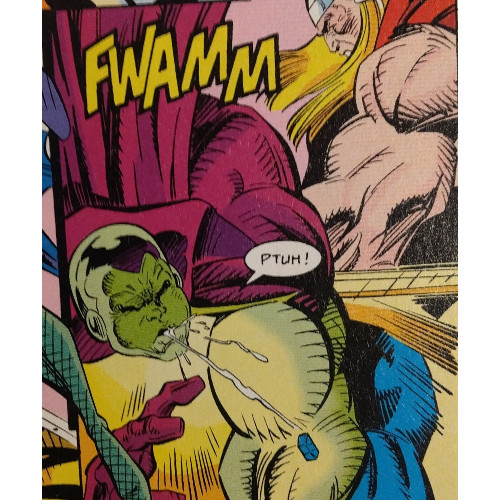
As I read, my brain repeatedly turned to "Maximum Carnage," a Spider-Man crossover published around the same time as this tale. In reviewing that story (or what the assembled creative team attempted to sell as a "story"), I discussed the mindlessness of the plot, of how a series of battles between bad guys and good guys felt like running inside a hamster wheel–lotta motion, little movement. Thor: Blood and Thunder provides a very similar reading experience, twelve issues of bashing and beating, with very little substance to show at the end of the crossover. There is blood, and there is thunder, but it's really just a speck of red and an empty echoing of crashing symbols in the dark sky.
Thor has fallen into a worrisome "warrior madness," as the tale begins, which concerns allies for two reasons: first, this madness, instigated for reasons unknown, is driving Thor towards the goal of utterly destroying Asgard and, quite possibly, the known universe. Second, Odin has decreed that anyone afflicted with "warrior madness" is to be banned forever from the Realm Eternal, if not annihilated outright. With those horrible facts in mind, several of Thor's allies, including Lady Sif, Beta Ray Bill, the Silver Surfer, Doctor Strange, the Infinity Watch, and Thanos, work both independently and collectively to stop Thor before he can reach Asgard…and before Odin can learn of his son's madness.
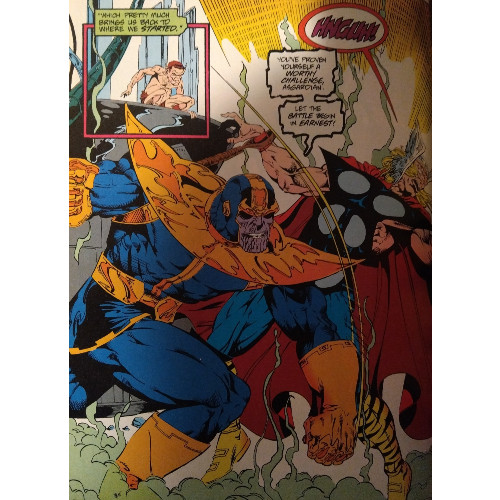
That's the basic premise, and if you know that, you're about 75% finished with this story before you read a single word. This is it. Thor has gone mad, and a group of heroes (plus one sometimes-villain) need to pry him from this madness before he can destroy Asgard or be destroyed himself. This is what makes a narrative like this difficult to read and review. There are battles galore, a big old brouhaha every issue, and it's these battles which serve as connecting links between installments. There's no deeper lesson to be learned, no senses-shattering plot twist, no satisfying character insights, and not many moral conundrums to be found. It's a lotta punching, usually in space, for twelve issues.
I won't completely decry all the punching. Starlin and Marz do offer a few significant beat-em-ups, and before you realize the entire volume is like this, the first few fights feel entertaining. Thor goes head-to-head with Sif, brother-in-arms Beta Ray Bill, and the Surfer across two issues in a battle set in an asteroid field. The volume's rapid fire format of fierce fights has not settled in yet, meaning this clash stands out, and it's a pretty dramatic conflict. There is a somewhat emotional touch as you realize Bill and Sif are fighting a god they deeply love, and in other instances, Starlin and Marz do note the misfortune of Thor's descent into brutish violence. He's a god, a hero, and the tragedy of it is seeing a noble being such as himself become the opposite of himself. This potential theme, however, is generally lost amidst the bruising and bashing.
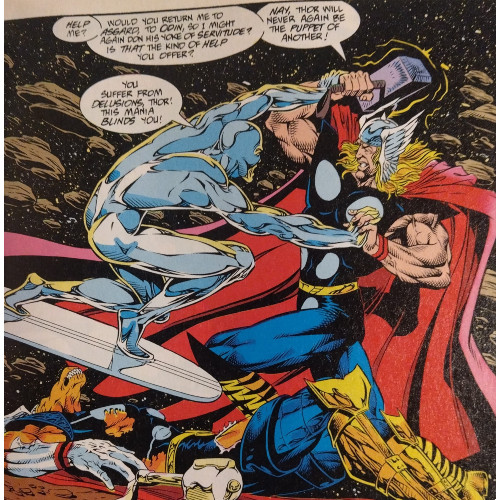
Some standout moments do occur which give the illusion of progress–Thor, in one battle with the Infinity Watch, wrenches control of the Infinity Gem Drax possesses, affixing it to his forehead and increasing his own strength. The turn intends to make Thor that much more of a menace, but in execution, it simply means he's a stronger fighter. Better written is the Infinity Watch's conflict with Asgardian warriors; teamed with the Mad Titan Thanos, they approach the Rainbow Bridge and are countered by soldiers. This leads to an absolutely titanic fight between Thanos and Odin, two beings unleashing their internal storehouses of raw power against one another. It is by far the most entertaining sequence of the entire narrative, seeing the wannabe god pitted against the all-seeing father of the Norse pantheon.
These fights are the exception to the rule, however, and that rule is stagnancy. With every fight, Thor does move closer to his goal, halted at moments by our heroes, but as the issues progress, the feeling that Starlin and Marz are crafting filler to pad the page count is palpable. One issue sees the Infinity Watch battle trolls in perhaps the most flagrant example of fill-in material in the whole narrative, a plot point which feels hilariously secondary to the larger events occurring and ends up being a distraction to the entire story. Were it a character-driven issue, developed as a breather between conflicts, I would have appreciated it. But I'll return to the hamster wheel metaphor–we spin and spin and spin, and it feels like we don't end up anywhere else.
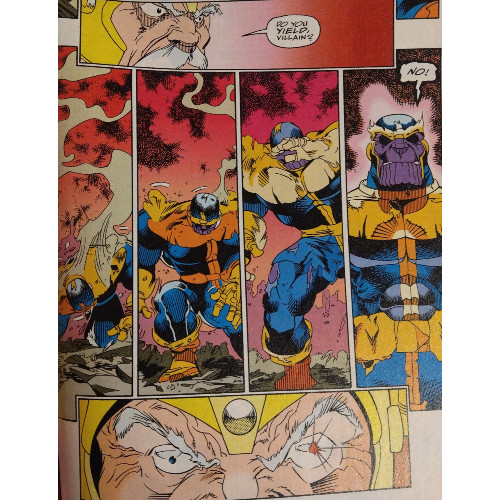
Of course, the story ends well. Not too much of a spoiler there. Fans reading Thor comics today know the Thunder God is no longer a victim of madness. There is a reason for Thor's madness, tethered somewhat to his experiences with Eric Masterson, as we learn in the final issue, but this is given attention only in the conclusion. Odin plays a significant role in dealing with the conflict in a way which wraps everything up nicely and further hampers the effects of the preceding issues–he offers a solution which could have wrapped the whole debacle up a lot sooner, meaning everything which came before feels based on speculation and is made even less impactful than it already is. A messy beginning and messy middle are given a conveniently tidy ending, which I feel robs the story of potential heft.
Artistically, I didn't find much I could give a standing ovation to–the art is fine, presented in typical 90s fashion by our pencilers, inkers, and colorists. No sequence stood out as overly grand or memorable, save the Thanos/Odin fight. Annoyingly, mistakes can be found between the issues of the three series collected, particularly with the inconsistency in which Lady Sif is drawn. Appearing in the first two chapters, the opening Thor and Silver Surfer issues, she's illustrated with different armor and an inconsistent hair color., this error repreats a few times throughout the volume. Normally, I could be more forgiving of such a mistake, and I will recognize that different creative teams worked on these titles (save for writer Ron Marz and editor-in-chief Tom DeFalco). Given the lackluster narrative we're presented, however, I feel more critical about this, and I do think greater communication between creative teams could have caught this mistake, especially in the earlier issues.
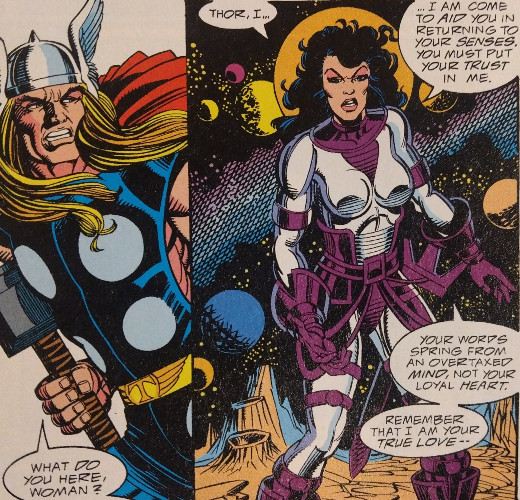
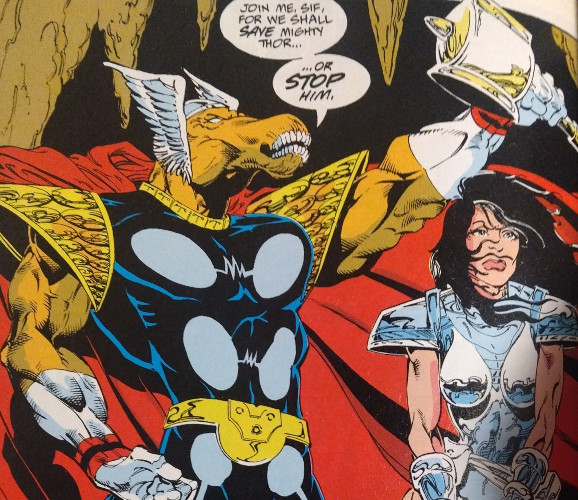
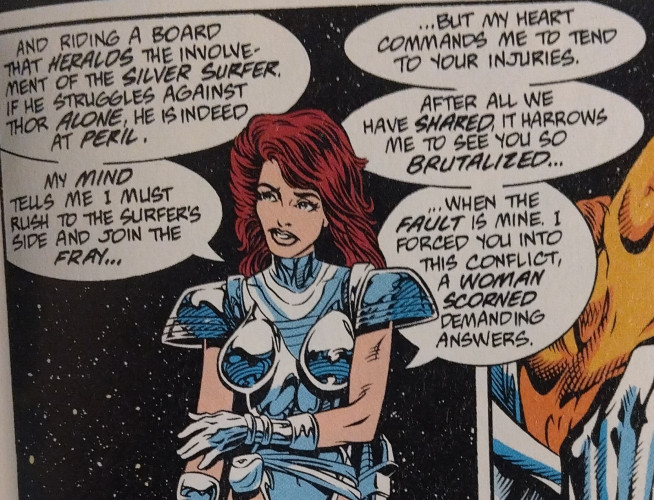
Maybe I'm the one who's strapped an Infinity Gem to my forehead and have angrily sworn revenge on Asgard. Coming back to "Maximum Carnage" momentarily, I'm almost inclined to say "Blood and Thunder" is worse, because at least "Carnage" endeavored to provide some character development, even if I felt it failed to do so. Here, there's pretty much none of that. We get a lot of Thor swearing to destroy Asgard and superpowered people trying to stop him. They're heroic, I'll give 'em that. They fight and fight and fight, no matter how many times Thor knocks them around. But Thor shouldn't have to keep knocking them around only for them to pick themselves up again like reset bowling pins. Something else should happen, something more meaningful. With thunder, there should come lighting, some bright spark in response to the crashing and booming. But there's only noise, a discordant clamor rumbling through the air before fading with a storm that never materializes.